Charles E W Bean, Diaries, AWM38 3DRL 606/1/1 - October - December 1914 - Part 1
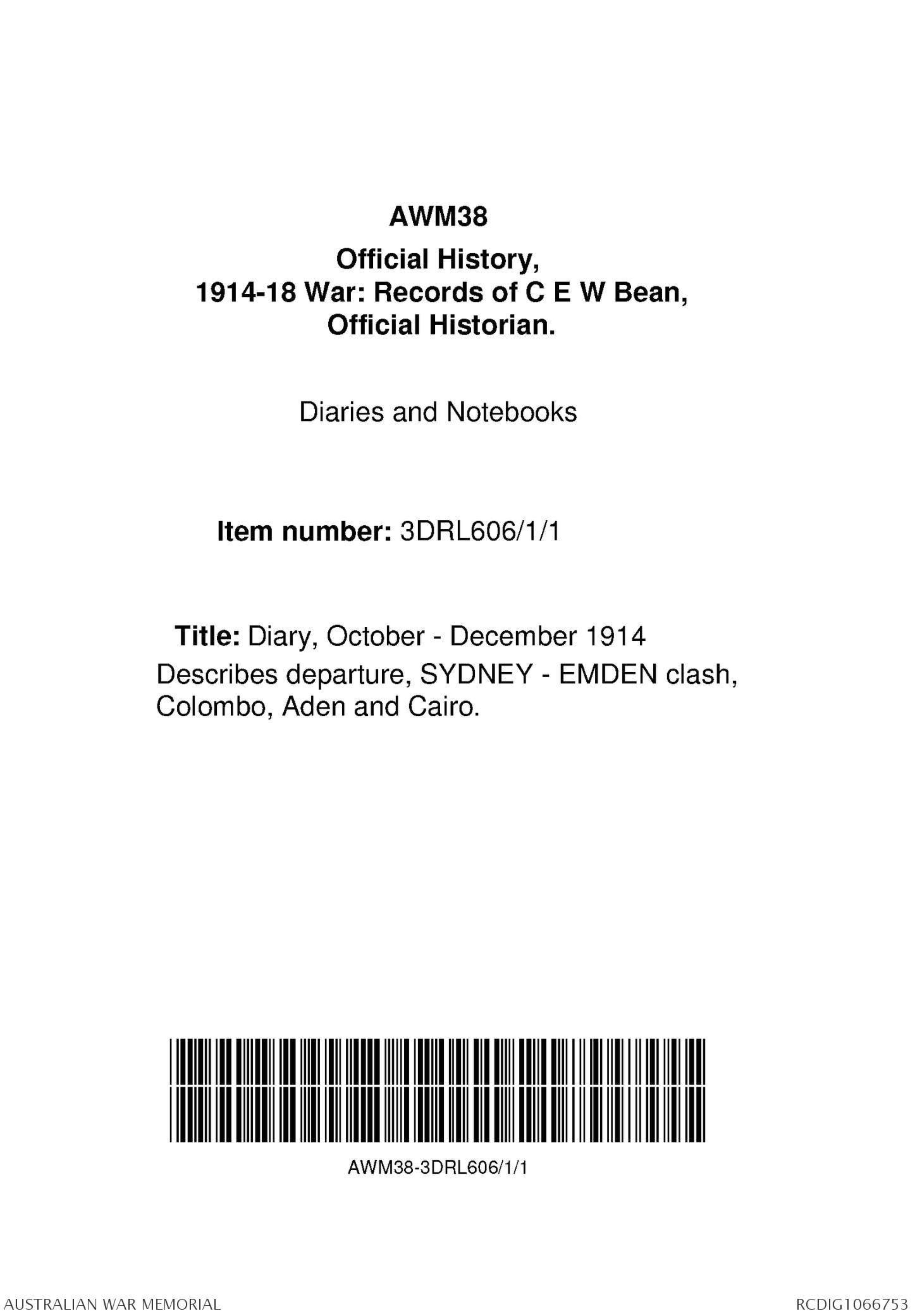
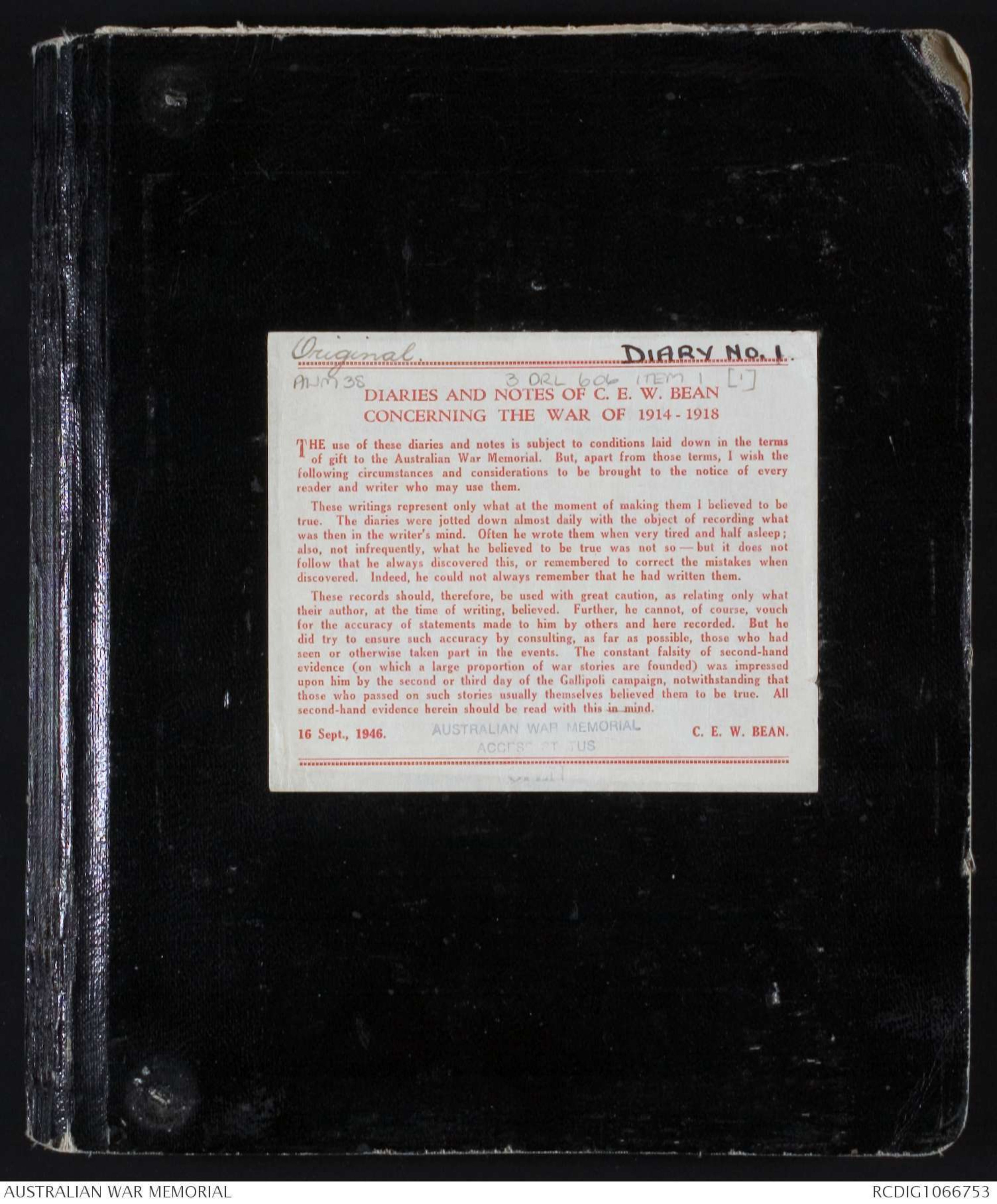
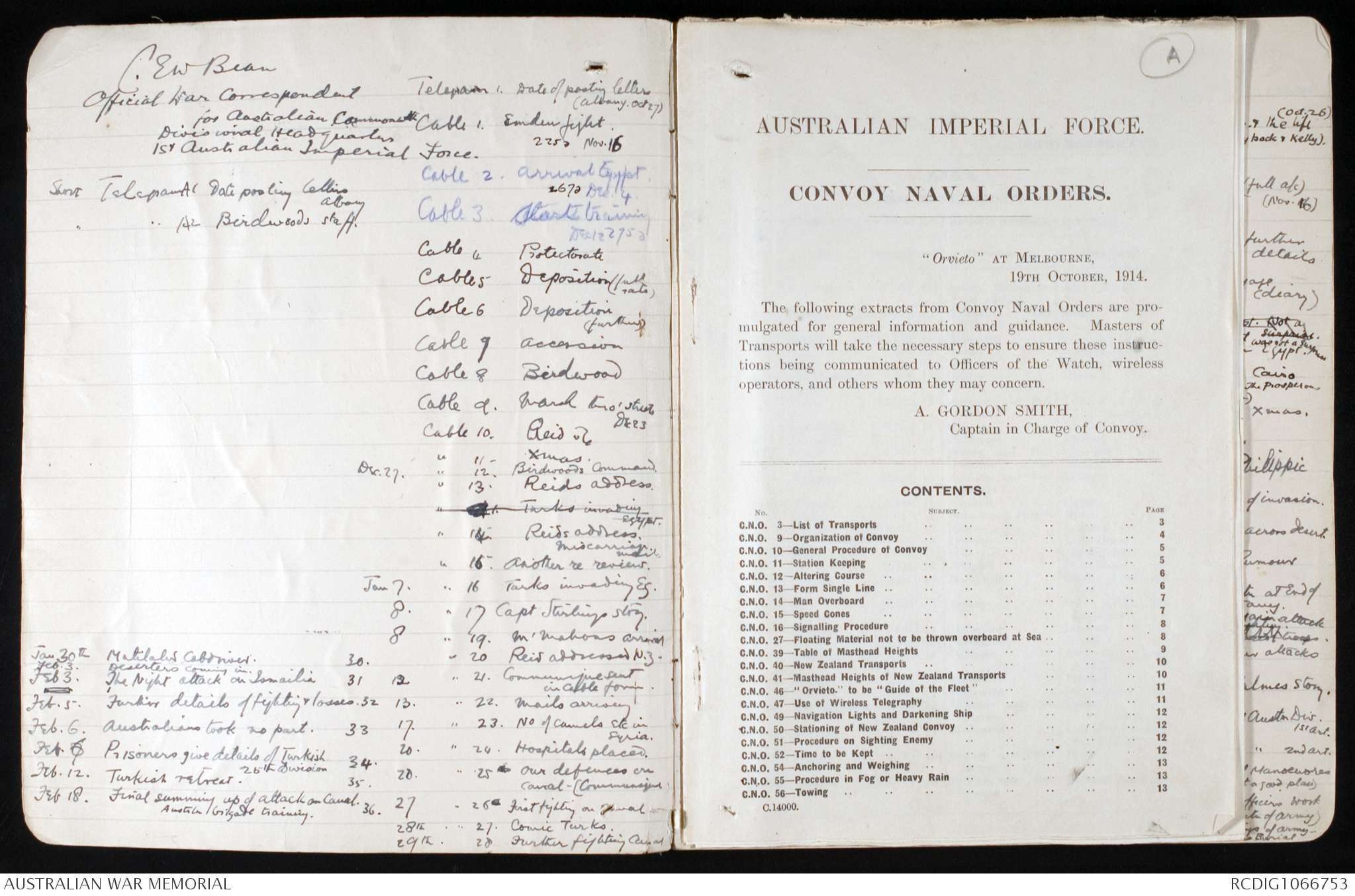
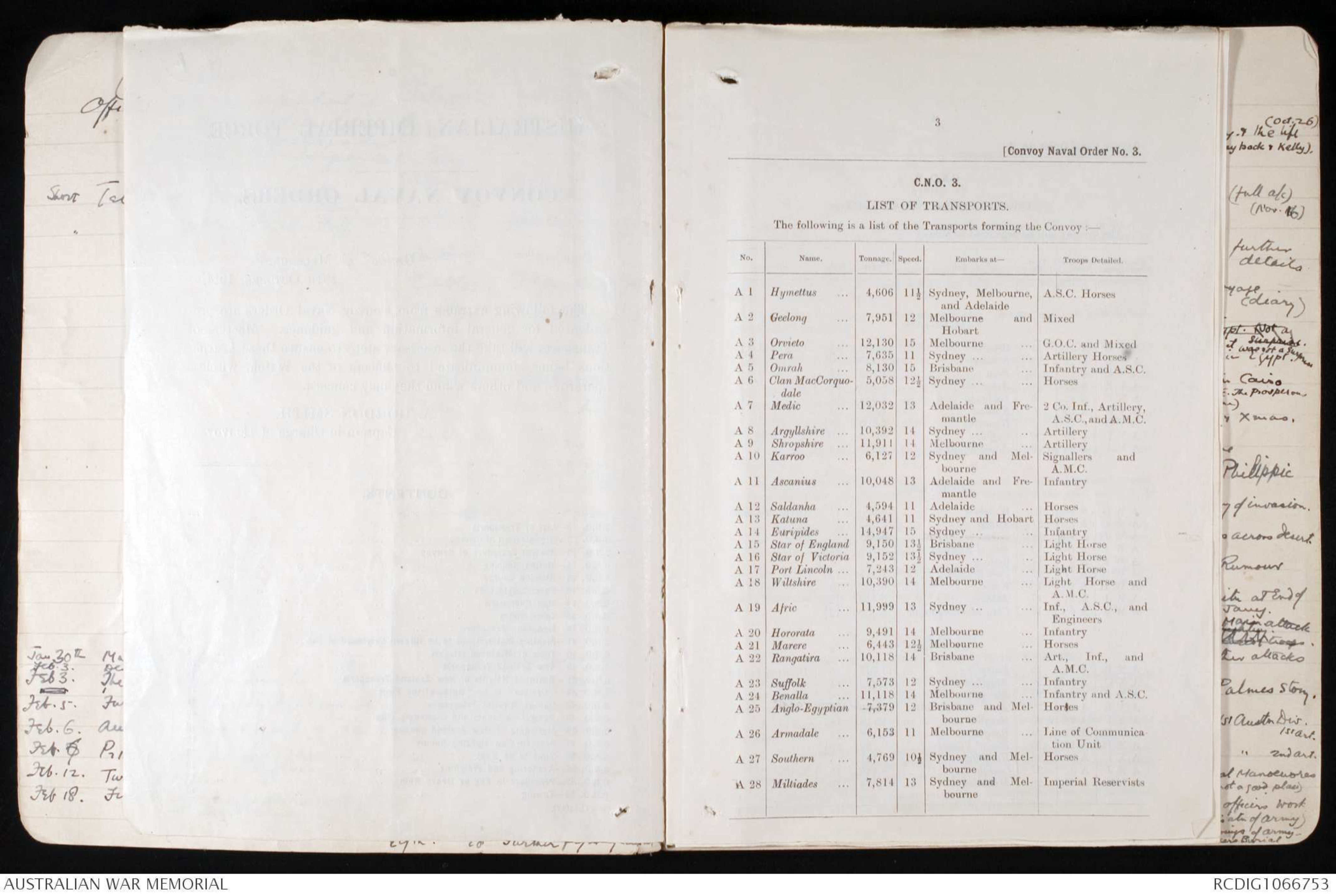
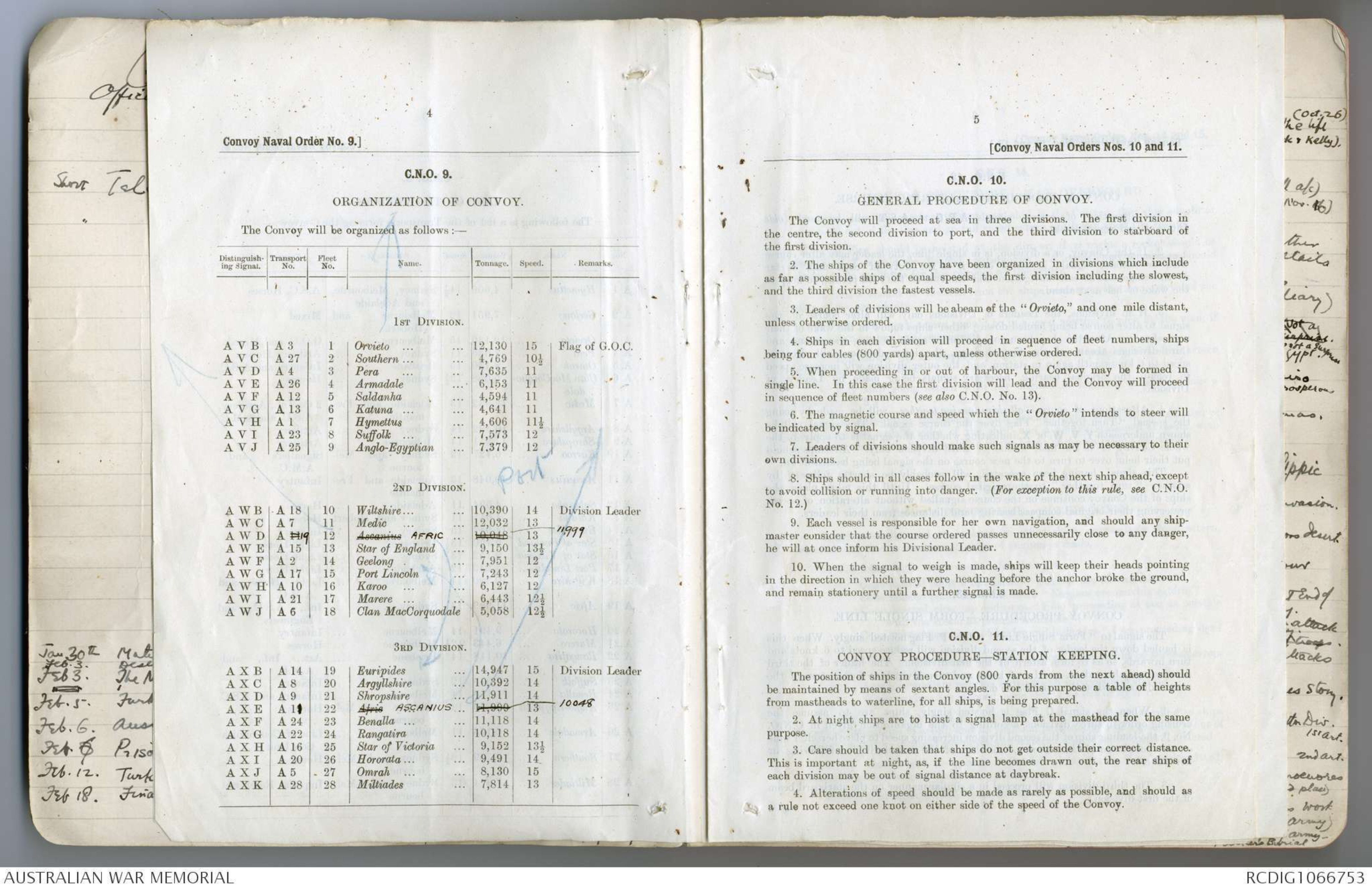
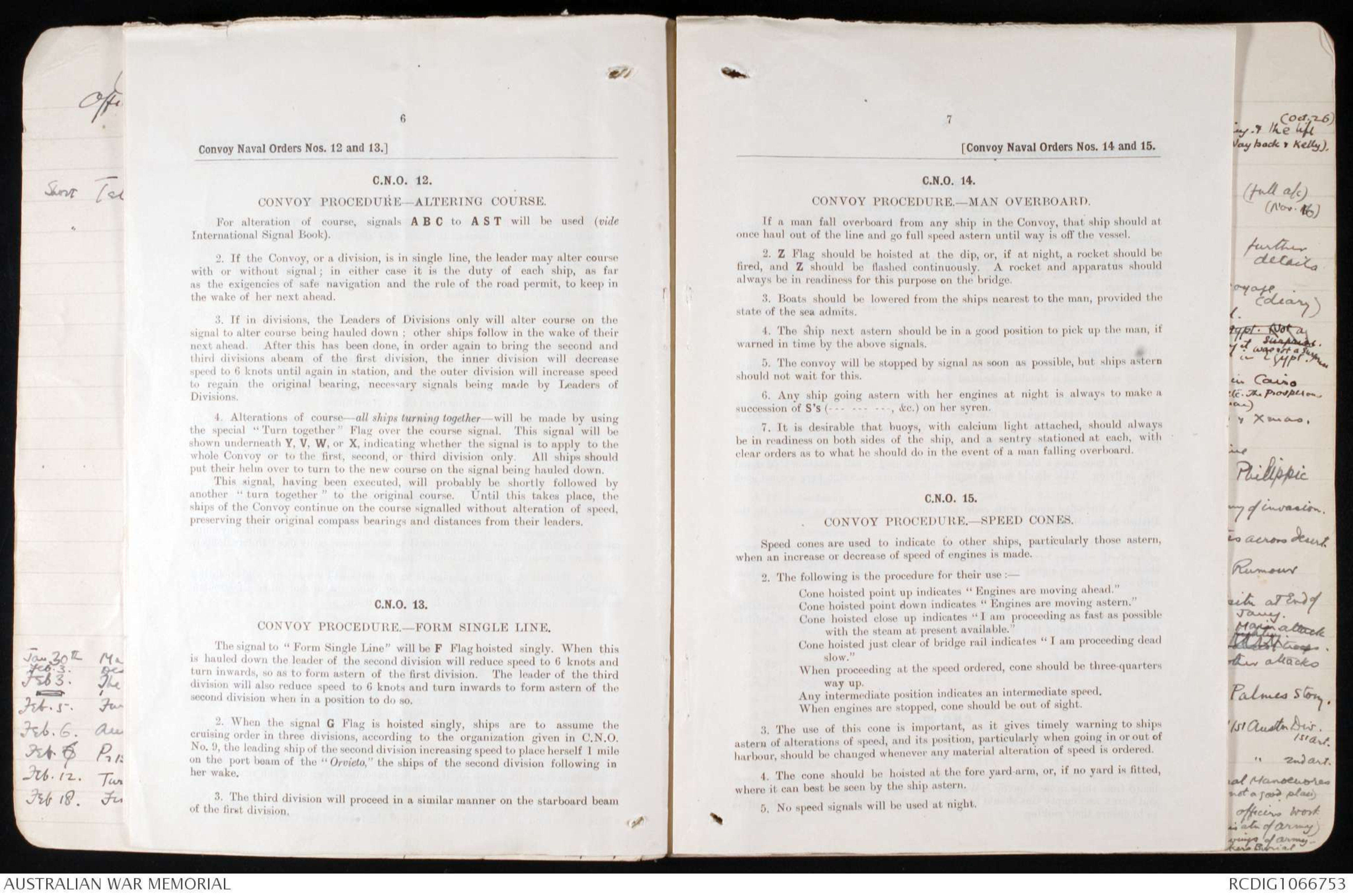
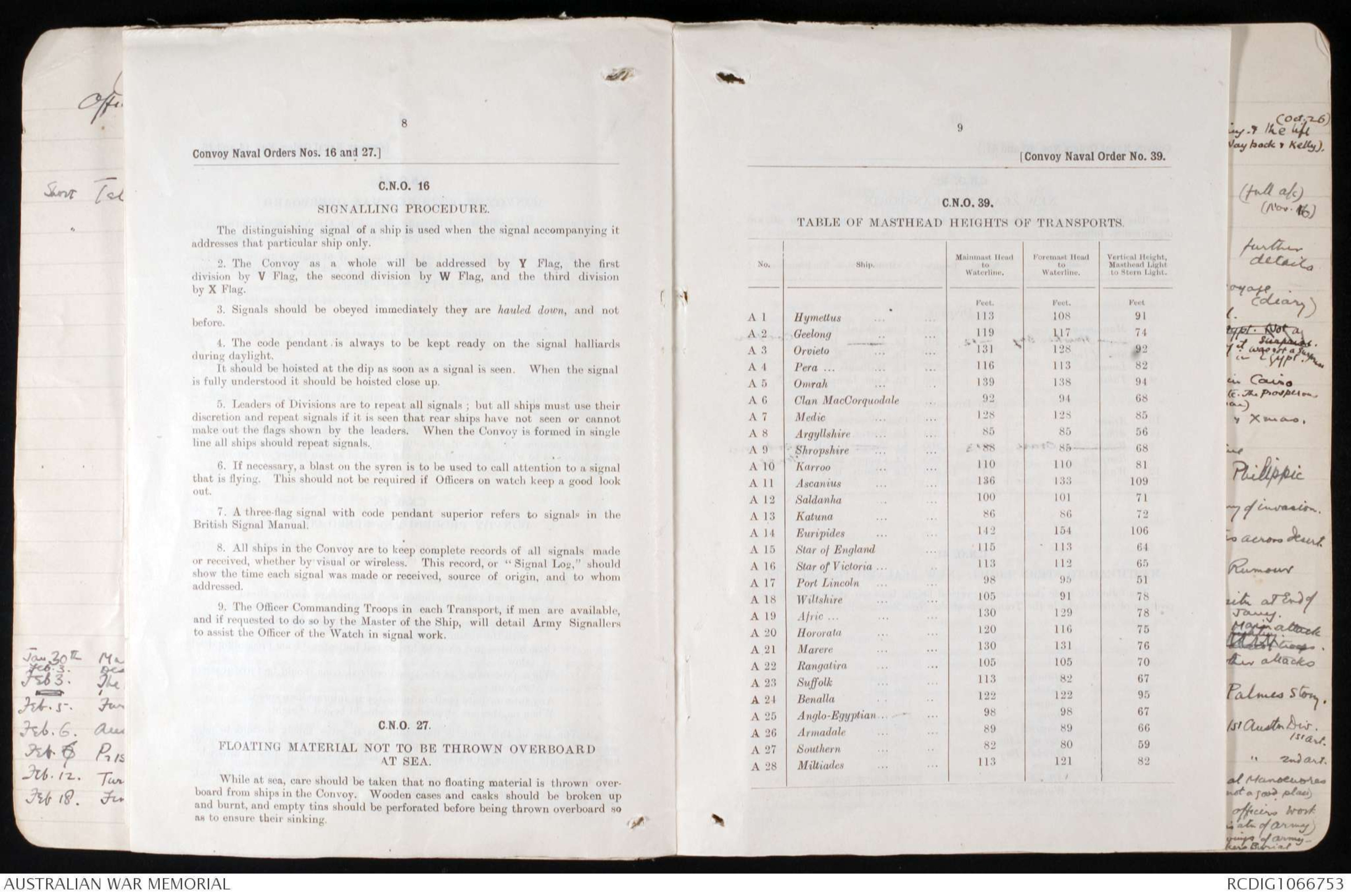
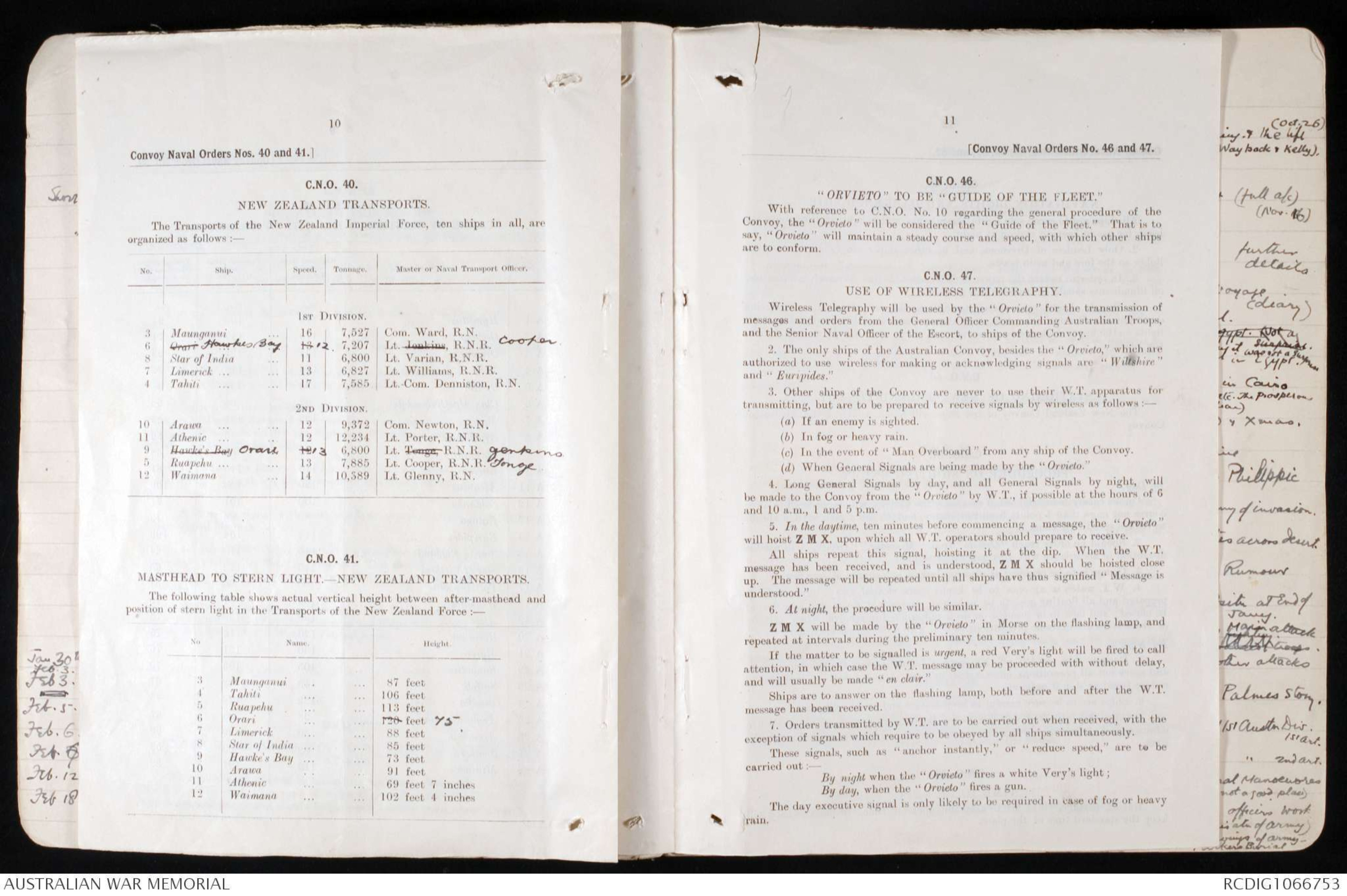
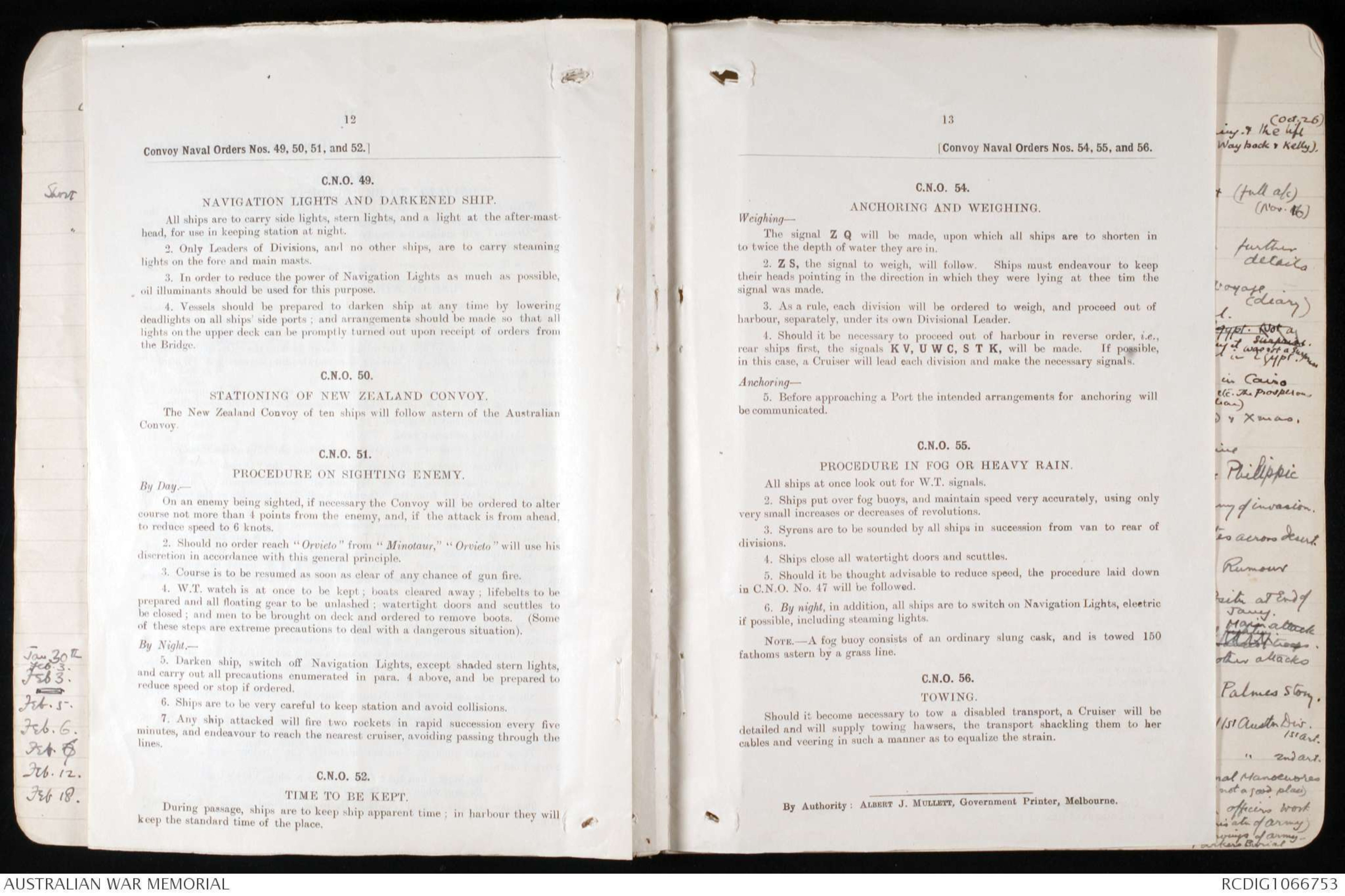
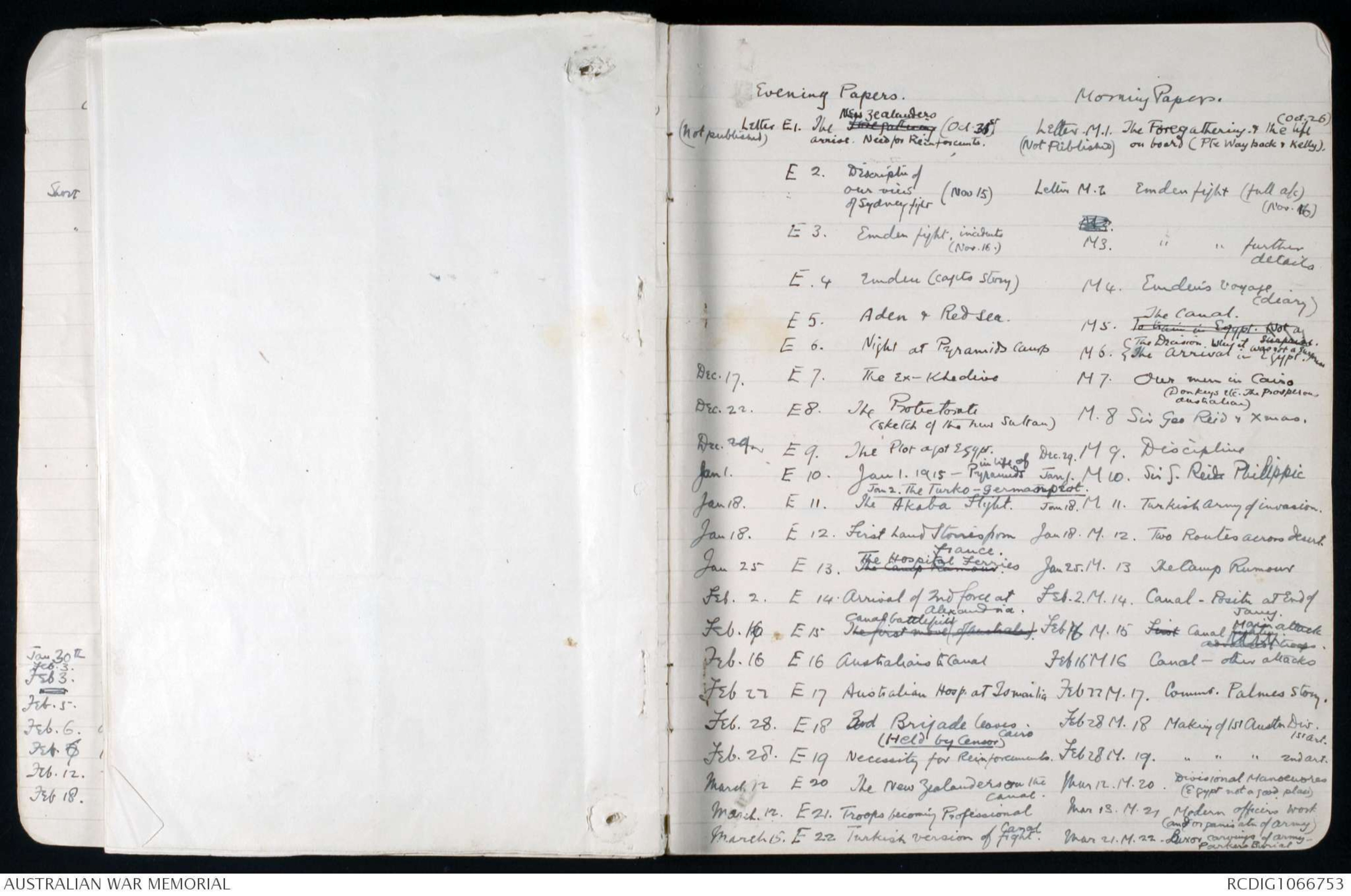
AWM38
Official History,
1914-18 War: Records of C E W Bean,
Official Historian.
Diaries and Notebooks
Item number: 3DRL606/1/1
Title: Diary, October - December 1914
Describes departure, SYDNEY - EMDEN clash,
Colombo, Aden and Cairo.
AWM38-3DRL606/1/1
Original. DIARY NO. 1.
AWM38 3 DRL 606 ITEM 1 [1]
DIARIES AND NOTES OF C. E. W. BEAN
CONCERNING THE WAR OF 1914 - 1918
THE use of these diaries and notes is subject to conditions laid down in the terms
of gift to the Australian War Memorial. But, apart from those terms, I wish the
following circumstances and considerations to be brought to the notice of every
reader and writer who may use them.
These writings represent only what at the moment of making them I believed to be
true. The diaries were jotted down almost daily with the object of recording what
was then in the writer's mind. Often he wrote them when very tired and half asleep ;
also, not infrequently, what he believed to be true was not so - but it does not
follow that he always discovered this, or remembered to correct the mistakes when
discovered. Indeed, he could not always remember that he had written them.
These records should, therefore, be used with great caution, as relating only what
their author, at the time of writing, believed. Further, he cannot, of course, vouch
for the accuracy of statements made to him by others and here recorded. But he
did try to ensure such accuracy by consulting, as far as possible, those who had
seen or otherwise taken part in the events. The constant falsity of second-hand
evidence (on which a large proportion of war stories are founded) was impressed
upon him by the second or third day of the Gallipoli campaign, notwithstanding that
those who passed on such stories usually themselves believed them to be true. All
second-hand evidence herein should be read with this in mind.
16 Sept., 1946. C. E. W. BEAN
AUSTRALIAN WAR MEMORIAL
ACCESS STATUS
OPEN
CEW Bean
Official War Correspondent
for Australian Commonwealth
Divisional Headquarters
1st Australian Imperial Force.
Short Telegram A1 Date posting Collins
Albany
" " A2 Birdwoods staff.
Telegram 1. Date of posting letters
(Albany. Oct 27)
Cable 1. Emden fight
2252 Nov. 16
Cable 2. Arrival Egypt
2672 Dec. 4
Cable 3. Started training
Dec 12 2752
Cable 4 Protectorate
Cable 5 Deposition (full rate)
Cable 6 Deposition
(further)
Cable 7 Accession
Cable 8 Birdwood
Cable 9. March thro' streets
Dec 23
Cable 10. Reid [[shorthand]]
" 11 - Xmas.
Dec.27. " 12. Birdwoods Command
" 13. Reids address
" 14. Turks invading Egypt.
" 14. Reids address.
Miscarriage. mail.
" 15. Another re review.
Jan 7. " 16. Turks invading Eg.
8. " 17. Capt Stirlings story.
8 " 19. McMahons arrival
" 20. Reid addressed N.Z.
12 " 21. Communique sent
in cable form.
13. " 22. Mails arriving
17. " 23. No of camels etc in
Syria.
20. " 24. Hospitals placed.
20. " 25th Our defences on
canal. (Communique)
27 " 26th First fighting on Canal
28th " 27. Comic Turks.
29th " 28 Further fighting Canal
Jan 30th Matilalin Cabdriver. 30.
Feb. 3. Deserters coming in .
Feb.3. The Night attack on Ismailia 31
Feb. 5. Further details of fighting & losses. 32
Feb. 6. Australians took no part. 33.
Feb. 7 Prisoners give details of Turkish 34.
25th Division
Feb. 12. Turkish retreat. 35.
Feb 18. Final summing up of attack on Canal. 36.
Australian brigade training.
A
AUSTRALIAN IMPERIAL FORCE.
CONVOY NAVAL ORDERS.
"Orvieto" AT MELBOURNE,
19TH OCTOBER, 1914.
The following extracts from Convoy Naval Orders are
promulgated for general information and guidance. Masters of
Transports will take the necessary steps to ensure these instructions
being communicated to Officers of the Watch, wireless
operators, and others whom they may concern.
A. GORDON SMITH,
Captain in Charge of Convoy.
CONTENTS.
No. SUBJECT PAGE
C.N.O. 3 - List of Transports 3
C.N.O. 9 - Organization of Convoy 4
C.N.O. 10 - General Procedure of Convoy 5
C.N.O. 11 - Station Keeping 5
C.N.O. 12 - Altering Course 6
C.N.O 13 - Form Single Line 6
C.N.O. 14 - Man Overboard 7
C.N.O. 15 - Speed Cones 7
C.N.O. 16 - Signalling Procedure 8
C.N.O. 27 - Floating Material not to be thrown overboard at Sea 8
C.N.O. 39 - Table of Masthead Heights 9
C.N.O. 40 - New Zealand Transports 10
C.N.O. 41 - Masthead Heights of New Zealand Transports 10
C.N.O. 46 - "Orvieto." to be "Guide of the Fleet" 11
C.N.O. 47 - Use of Wireless Telegraphy 11
C.N.O. 49 - Navigation Lights and Darkening Ship 12
C.N.O. 50 - Stationing of New Zealand Convoy 12
C.N.O. 51 - Procedure on Sighting Enemy 12
C.N.O. 52 - Time to be Kept 12
C.N.O. 54 - Anchoring and Weighing 13
C.N.O. 55 - Procedure in Fog or Heavy Rain 13
C.N.O. 56 - Towing 13
C.14000.
3.
[Convoy Naval Order No. 3.
C.N.O 3.
LIST OF TRANSPORTS.
The following is a list of the Transports forming the Convoy :—
| No |
Name |
Tonnage |
Speed |
Embarks at -- |
Troops Detailed |
| A 1 | Hymettus |
4,606 |
11 ½ |
Sydney, Melbourne, and Adelaide |
A.S.C. Horses |
| A 2 | Geelong |
7,951 |
12 |
Melbourne and Hobart |
Mixed |
| A 3 | Orvieto |
12,130 |
15 |
Melbourne | G.O.C. and Mixed |
| A 4 | Pera |
7,635 |
11 |
Sydney | Artillery Horses |
| A 5 | Omrah |
8,130 |
15 |
Brisbane | Infantry and A.S.C. |
| A 6 | Clan MacCorquodale |
5,058 |
12 ½ |
Sydney | Horses |
| A 7 | Medic |
12,032 |
13 |
Adelaide and Fremantle |
2 Co. Inf., Artillery, A.S.C, and A.M.C. |
| A 8 | Argyllshire |
10,392 |
14 |
Sydney | Artillery |
| A 9 | Shropshire |
11,911 |
14 |
Melbourne | Artillery |
| A 10 | Karroo |
6,127 |
12 |
Sydney and Melbourne |
Signallers and A. M. C |
| A 11 | Ascanius |
10,048 |
13 |
Adelaide and Fremantle | Infantry |
| A 12 | Saldanha |
4,594 |
11 |
Adelaide | Horses |
| A 13 | Katuna |
4,641 |
11 |
Sydney and Hobart | Horses |
| A 14 | Euripides |
14,947 |
15 |
Sydney | Infantry |
| A 15 | Star of England |
9,150 |
13 ½ |
Brisbane | Light Horse |
| A 16 | Star of Victoria |
9,152 |
13 ½ |
Sydney | Light Horse |
| A 17 | Port Lincoln |
7,243 |
12 |
Adelaide | Light horse |
| A 18 | Wiltshire |
10,390 |
14 |
Melbourne | Light horse and A.M.C. |
| A 19 | Afric |
11,999 |
13 |
Sydney | Inf., A.S.C., and Engineers |
| A 20 | Hororata |
9,491 |
14 |
Melbourne | Infantry |
| A 21 | Marere |
6,443 |
12 ½ |
Melbourne | Horses |
| A 22 | Rangatira |
10,118 |
14 |
Brisbane | Art., Inf., and A.M.C. |
| A 23 | Suffolk |
7,573 |
12 |
Sydney | Infantry |
| A 24 | Benalla |
11,118 |
14 |
Melbourne | Infantry and A.S.C. |
| A 25 | Anglo-Egyptian |
7,379 |
12 |
Brisbane and Melbourne | Horses |
| A 26 | Armadale |
6,153 |
11 |
Melbourne | Line of Communication Unit |
| A 27 | Southern |
4,769 |
10 ½ |
Sydney and Melbourne | Horses |
| A 28 | Miltiades |
7,814 |
13 |
Sydney and Melbourne | Imperial Reservists |
4
Convoy Naval Order No. 9.]
C.N.O. 9.
ORGANIZATION OF CONVOY.
The Convoy will be organised as follows:—
___________________________________________________________________________
Distinguishing Transport Fleet Name. Tonnage. Speed. Remarks.
Signals. No. No.
____________________________________________________________________________
1ST DIVISION.
A V B A 3 1 Orivieto 12,130 15 Flag of G.O.C.
A V C A 27 2 Southern 4,769 10½
A V D A 4 3 Pera 7,635 11
A V E A 26 4 Armadale 6,153 11
A V F A 12 5 Saldanha 4,594 11
A V G A 13 6 Katuna 4,641 11
A V H A 1 7 Hymettus 4,606 11 ½
A V I A 23 8 Suffolk 7,573 12
A V J A 25 9 Anglo-Egyptian 7,379 12
[*Port*]
2ND DIVISION.
A W B A 18 10 Wiltshire 10,390 14 Division Leader
A W C A 7 11 Medic 12,032 13
A W D A 11 19 12 Ascanius AFRIC 10,048 13 11,999
A W E A 15 13 Star of England 9,150 13 ½
A W F A2 14 Geelong 7,951 12
A W G A 17 15 Port Lincoln 7,243 12
A W H A 10 16 Karoo 6,127 12
A W I A 21 17 Marere 6,443 12 ½
A W J A 6 18 Clan MacCorquodale 5,058 12 ½
3RD DIVISION.
A X B A 14 19 Euripides 14,947 15 Division Leader
A X C A 8 20 Argyllshire 10,392 14
A X D A 9 21 Shropshire 11,911 14
A X E A 11 22 Afris ASCANIUS 11,999 13 10048
A X F A 24 23 Benalla 11,118 14
A X G A 22 24 Rangatira 10,118 14
A X H A 16 25 Star of Victoria 9,152 13½
A X I A 20 26 Hororata 9,491 14
A X J A 5 27 Omrah 8,130 15
A X K A 28 28 Miltiades 7,814 13
5
[Convoy Naval Orders Nos. 10 and 11.
C.N.O. 10.
GENERAL PROCEDURE OF CONVOY.
The Convoy will proceed at sea in three divisions. The first division in
the centre, the second division to port, and the third division to starboard of
the first division.
2. The ships of the Convoy have been organized in divisions which include
as far as possible ships of equal speeds, the first division including the slowest,
and the third division the fastest vessels.
3. Leaders of divisions will be abeam of the "Orvieto," and one mile distant,
unless otherwise ordered.
4. Ships in each division will proceed in sequence of fleet numbers, ships
being four cables (800 yards) apart, unless otherwise ordered.
5. When proceeding in or out of harbour, the Convoy may be formed in
single line. In this case the first division will lead and the Convoy will proceed
in sequence of fleet numbers (see also C.N.O. No. 13).
6. The magnetic course and speed which the "Orvieto" intends to steer will
be indicated by signal.
7. Leaders of divisions should make such signals as may be necessary to their
own divisions.
8. Ships should in all cases follow in the wake of the next ship ahead, except
to avoid collision or running into danger. (For exception to this rule, see C.N.O.
No. 12.)
9. Each vessel is responsible for her own navigation, and should any shipmaster
consider that the course ordered passes unnecessarily close to any danger,
he will at once inform his Divisional Leader.
10. When the signal to weigh is made, ships will keep their heads pointing
in the direction in which they were heading before the anchor broke the ground,
and remain stationery until further signal is made.
C.N.O. 11.
CONVOY PROCEDURE - STATION KEEPING.
The position of ships in the Convoy (800 yards from the next ahead) should
be maintained by means of sextant angles. For this purpose a table of heights
from mastheads to waterline, for all ships, is being prepared.
2. At night ships to hoist a signal lamp at the masthead for the same
purpose.
3. Care should be taken that ships do not get outside their correct distance.
This is important at night, as, if the line becomes drawn out, the rear ships of
each division may be out of signal distance at daybreak.
4. Alterations of speed should be made as rarely as possible, and should as
a rule not exceed one knot on either side of the speed of the Convoy.
6
Convoy Naval Orders Nos. 12 and 13. ]
C.N.O. 12.
CONVOY PROCEDURE—ALTERING COURSE.
For alteration of course, signals A B C to A S T will be used (vide
International Signal Book).
2. If the Convoy, or a division, is in single line, the leader may alter course
with or without signal ; in either case it is the duty of each ship, as far
as the exigencies of safe navigation and the rule of the road permit, to keep in
the wake of her next ahead.
3. If in divisions, the Leaders of Divisions only will alter course on the
signal to alter course being hauled down ; other ships follow in the wake of their
next ahead. After this has been done, in order again to bring the second and
third divisions abeam of the first division, the inner division will decrease
speed to 6 knots until again in station, and the outer division will increase speed
to regain the original bearing, necessary signals being made by Leaders of
Divisions.
4. Alterations of course - all ships turning together - will be made by using
the special "Turn together" Flag over the course signal. This signal will be
shown underneath Y, V, W, or X, indicating whether the signal is to apply to the
whole Convoy or to the first, second, or third division only. All ships should
put their helm over to turn to the new course on the signal being hauled down.
This signal, having be executed, will probably be shortly followed by
another " turn together " to the original course. Until this takes place, the
ships of the Convoy continue on the course signalled without alteration of speed,
preserving their original compass bearings and distances from their leaders.
C.N.O. 13.
CONVOY PROCEDURE—FORM SINGLE LINE.
The signal to " Form Single Line " will be F Flag hoisted singly. When this
is hauled down the leader of the second division will reduce speed to 6 knots and
turn inwards, so as to form astern of the first division. The leader of the third
division will also reduce speed to 6 knots and turn inwards to form astern of the
second division when in a position to do so.
2. When the signal G Flag is hoisted singly, ships are to assume the
cruising order in three divisions, according to the organization given in C.N.O.
No. 9, the leading ship of the second division increasing speed to place herself 1 mile
on the port beam of the "Orvieto," the ships of the second division following in
her wake.
3. The third division will proceed in a similar manner on the starboard beam
of the first division.
7. [Convoy Naval Orders Nos. 14 and 15.
C.N.O. 14.
CONVOY PROCEDURE.—MAN OVERBOARD.
If a man fall overboard from any ship in the Convoy, that ship should at
once haul out of the line and go full speed astern until way is off the vessel.
2. Z Flag should be hoisted at the dip, or, if at night, a rocket should be
fired, and Z should be flashed continuously. A rocket and apparatus should
always be in readiness for this purpose on the bridge.
3. Boats should be lowered from the ships nearest to the man, provided the
state of the sea admits.
4. The ship next astern should be in a good position to pick up the man, if
warned in time by the above signals.
5. The convoy will be stopped by signal as soon as possible, but ships astern
should not wait for this.
6. Any ship going astern with her engines at night is always to make a
succession of S's ( - - - - - - - - - ,&c.) on her syren.
7. It is desirable that buoys, with calcium light attached, should always
be in readiness on both sides of the ship, and a sentry stationed at each, with
clear orders as to what he should do in the event of a man falling overboard.
C.N.O. 15.
CONVOY PROCEDURE.—SPEED CONES.
Speed cones are used to indicate to other ships, particularly those astern,
when an increase or decrease of speed of engines is made.
2. The following is the procedure for their use :—
Cone hoisted point up indicates "Engines are moving ahead."
Cone hoisted point down indicates : "Engines are moving astern".
Cone hoisted close up indicates "I am proceeding as fast as possible
with the steam at present available."
Cone hoisted just clear of the bridge rail indicates " I am proceeding dead
slow."
When proceeding at the speed ordered, cone should be three-quarters
way up.
Any intermediate position indicates an intermediate speed.
When engines are stopped, cone should be out of sight.
3. The use of this cone is important, as it gives timely warning to ships
astern of alterations of speed, and its position, particularly when going in or out of
harbour, should be changed whenever any material alteration of speed is ordered.
4. The cone should be hoisted at the fore yard-arm, or, if no yard is fitted,
where it can best be seen by the ship astern.
5. No speed signals will be used at night.
8
Convoy Naval Orders Nos. 16 and 27.]
C.N.O. 16.
SIGNALLING PROCEDURE.
The distinguishing signal of ship is used when the signal accompanying it
addresses that particular ship only.
2. The Convoy as a whole will be addressed by Y flag, the first
division by V Flag, the second division by W Flag, and the third division
by X Flag.
3. Signals should be obeyed immediately they are hauled down, and not
before.
4. The code pendant is always to be kept ready on the signal halliards
during daylight.
It should be hoisted at the dip as soon as a signal is seen. When the signal
is fully understood it should be hoisted close up.
5. Leaders of Divisions are to repeat all signals ; but all ships must use their
discretion and repeat signals if it is seen that rear ships have not seen or cannot
make out the flags shown by the leaders, When the Convoy is formed in single
line all ships should repeat signals.
6. If necessary, a blast on the syren is to be used to call attention to a signal
that is flying. This should not be required if Officers on watch keep a good look
out.
7. A three-flag signal with code pendant superior refers to signals in the
British Signal Manual.
8. All ships in the Convoy are to keep complete records of all signals made
or received, whether by visual or wireless. This record, or "Signal Log," should
show the time each signal was made or received, source of origin, and to whom
addressed.
9. The Officer Commanding Troops in each Transport, if men are available,
and if requested to do so by the Master of the Ship, will detail Army Signallers
to assist the Officer of the Watch in signal work.
C.N.O. 27.
FLOATING MATERIAL NOT TO BE THROWN OVERBOARD
AT SEA.
While at sea, care should be taken that no floating material is thrown overboard
from ships in the Convoy. Wooden cases and casks should be broken up
and burst, and empty tins should be perforated before being thrown overboard so
as to ensure their sinking.
9
[Convoy Naval Order No. 39.
C.N.O. 39.
TABLE OF MASTHEAD HEIGHTS OF TRANSPORTS.
______________________________________________________________________________
No. Ship. Mainmast Head Foremast Head Vertical Height,
to to Masthead Light
Waterline. Waterline. To Stern Light.
_______________________________________________________________________________
Feet. Feet. Feet.
A 1 Hymettus 113 108 91
A 2 Geelong 119 117 74
A 3 Orvieto 131 128 92
A 4 Pera 116 113 82
A 5 Omrah 139 138 94
A 6 Clan MacCorquodale 92 94 68
A 7 Medic 128 128 85
A 8 Argyllshire 85 85 56
A 9 Shropshire 88 85 68
A 10 Karroo 110 110 81
A 11 Ascanius 136 133 109
A 12 Saldanha 100 101 71
A 13 Katuna 86 86 72
A 14 Euripides 142 154 106
A 15 Star of England 115 113 64
A 16 Star of Victoria 113 112 65
A 17 Port Lincoln 98 95 51
A 18 Wiltshire 105 91 78
A 19 Afric 130 129 78
A 20 Hororata 120 116 75
A 21 Marere 130 131 76
A 22 Rangatira 105 105 70
A 23 Suffolk 113 82 67
A 24 Benalla 122 122 95
A 25 Anglo-Egyptian 98 98 67
A 26 Armadale 89 89 66
A 27 Southern 82 80 59
A 28 Miltiades 113 121 82
_________________________________________________________________________________
10
Convoy Naval Orders No. 40 and 41.]
C.N.O. 40.
NEW ZEALAND TRANSPORTS.
The Transports of the New Zealand Imperial Force, ten ships in all, are
organized as follows :—
________________________________________________________________________________
No. Ships. Speed. Tonnage. Master or Naval Transport Officer.
________________________________________________________________________________
1ST DIVISION.
3 Maunganui 16 7,527 Com. Ward, R.N.
6 Orari Hawkes Bay 13 12. 7,207 Lt. Jenkins, R.N.R. Cooper.
8 Star of India 11 6,800 Lt. Varian, R.N.R.
7 Limerick 13 6,827 Lt. Williams. R.N.R.
4 Tahiti 17 7,585 Lt.-Com. Denniston, R.N.
2ND DIVISION.
10 Arawa 12 9,372 Com. Newton, R.N.
11 Athenic 12 12,234 Lt. Porter, R.N.R.
9 Hawke's Bay Orari 12 13 6,800 Lt. Tonge, R.N.R. Genkins
5 Ruapehu 13 7,885 Lt. Cooper, R.N.R. Tonge
12 Waimana 14 10,389 Lt. Glenny, R.N.
__________________________________________________________________________________
C.N.O. 41.
MASTHEAD TO STERN LIGHT.—NEW ZEALAND TRANSPORTS.
The following table shows actual vertical height between after-masthead and
position of stern light in the Transports of the New Zealand Force :—
______________________________________________________________
No. Name. Height.
_______________________________________________________________
3 Maunganui 87 feet
4 Tahiti 106 feet
5 Ruapehu 113 feet
6 Orari 120 feet 75
7 Limerick 88 feet
8 Star of India 85 feet
9 Hawke's Bay 73 feet
10 Arawa 91 feet
11 Athenic 69 feet 7 inches
12 Waimana 102 feet 4 inches
___________________________________________________________________________
11
[Convoy Naval Orders No. 46 and 47.
C.N.O. 46.
"ORVIETO" TO BE "GUIDE OF THE FLEET."
With reference to C.N.O. No. 10 regarding the general procedure of the
Convoy, the "Orvieto" will be considered the "Guide of the Fleet." That is to
say, "Orvieto" will maintain a steady course and speed, with which other ships
are to conform.
C.N.O. 47.
USE OF WIRELESS TELEGRAPHY.
Wireless Telegraphy will be used by the "Orvieto" for the transmission of
messages and orders from the General Officer Commanding Australian Troops,
and the Senior Naval Officer of the Escort, to ships of the Convoy.
2. The only ships of the Australian Convoy, beside the "Orvieto," which are
authorized to use wireless for making acknowledging signals are "Wiltshire"
and "Euripides."
3. Other ships of the Convoy are never to use their W.T. apparatus for
transmitting, but are to be prepared to receive signals by wireless as follows: -
(a) If an enemy is sighted.
(b) In fog or heavy rain.
(c) In the event of "Man Overboard" from any ship of the Convoy.
(d) When General Signals are being made by the "Orvieto".
4. Long General Signals by day, and all General Signals by night, will
be made to the Convoy from the "Orvieto" by W.T., if possible at the hours of 6
and 10 a.m., 1 and 5 p.m.
5. In the daytime, ten minutes before commencing a message, the "Orvieto"
will hoist Z M X, upon which all W.T. operators should prepare to receive.
All ships repeat this signal, hoisting it at the dip. When the W.T.
message has been received, and is understood, Z M X should be hoisted close
up. The message will be repeated until all ships have thus signified "Message is
understood."
6. At night, the procedure will be similar.
Z M X will be made by the "Orvieto" in Morse on the flashing lamp, and
repeated at intervals during the preliminary ten minutes.
If the matter to be signalled is urgent, a red Very's light will be fired to call
attention, in which case the W.T. message may be proceeded with without delay,
and will usually be made "en clair".
Ships are to answer on the flashing lamp, both before and after the W.T.
message has been received.
7. Orders transmitted by W.T. are to be carried out when received, with the
exception of signals which require to be obeyed by all ships simultaneously.
These signals, such as "anchor instantly," or "reduce speed," are to be
carried out:-
By night when the "Orvieto" fires a white Very's light;
By day, when the "Orvieto" fires a gun.
The day executive signal is only likely to be required in case of fog or heavy
rain.
12
Convoy Naval Orders Nos. 49, 50, 51, and 52. ]
C.N.O. 49.
NAVIGATION LIGHTS AND DARKENED SHIP.
All ships are to carry side lights, stern lights, and a light at the after-masthead,
for use in keeping station at night.
2. Only leaders of Divisions, and no other ships, are to carry steaming
lights on the fore and main masts.
3. In order to reduce the power of Navigation Lights as much as possible,
oil illuminants should be used for this purpose.
4. Vessels should be prepared to darken ship at any time by lowering
deadlights on all ships' side ports ; and arrangements should be made so that all
lights on the upper deck can be promptly turned out upon receipt of orders from
the Bridge.
C.N.O. 50.
STATIONING OF NEW ZEALAND CONVOY.
The New Zealand Convoy of ten ships will follow astern of the Australian
Convoy.
C.N.O. 51.
PROCEDURE ON SIGHTING ENEMY.
By Day :—
On an enemy being sighted, if necessary the Convoy will be ordered to alter
course not more than 4 points from the enemy, and, if the attack is from ahead,
to reduce speed to 6 knots.
2. Should no order reach "Orvieto" from "Minotaur," "Orvieto" will use his
discretion in accordance with this general principle.
3. Course is to be resumed as soon as clear of any chance of gun fire.
4. W.T. watch is at once to be kept ; boats cleared away ; lifebelts to be
prepared and all floating gear to be unlashed ; watertight doors and scuttles to
be closed ; and men to be brought on deck and ordered to remove boots. (Some
of the steps are extreme precautions to deal with a dangerous situation).
By night :—
5. Darken ship, switch off Navigation Lights, except shaded stern lights,
and carry out all precautions enumerated in para. 4 above, and be prepared to
reduce speed or stop if ordered.
6. Ships are to be very careful to keep station and avoid collisions.
7. Any ship attacked will fire two rockets in rapid succession every five
minutes, and endeavour to reach the nearest cruiser, avoiding passing through the
lines.
C.N.O. 52.
TIME TO BE KEPT.
During passage, ships are to keep ship apparent time ; in harbour they will
keep the standard time of the place.
13
[Convoy Naval Orders Nos. 54, 55, and 56.
C.N.O. 54.
ANCHORING AND WEIGHING.
Weighing—
The signal Z Q will be made, upon which all ships are to shorten in
to twice the depth of water they are in.
2. Z S, the signal to weight, will follow. Ships must endeavour to keep
their heads pointing in the direction in which they were lying at thee tim the
signal was made.
3. As a rule, each division will be ordered to weigh, and proceed out of
harbour, separately, under its own Divisional Leader.
4. Should it be necessary to proceed out of harbour in reverse order, i.e.,
rear ships first, the signals K V, U W C, S T K, will be made. If possible,
in this case, a Cruiser will lead each division and make the necessary signals.
Anchoring—
5. Before approaching a Port the intended arrangements for anchoring will
be communicated.
C.N.O. 55.
PROCEDURE IN FOG OR HEAVY RAIN.
All ships at once look out for W.T. signals.
2. Ships put over fog buoys, and maintain speed very accurately, using only
very small increases or decreases of revolutions.
3. Syrens are to be sounded by all ships in succession from van to rear of
divisions.
4. Ships close all watertight doors and scuttles.
5. Should it be thought advisable to reduce speed, the procedure laid down
in C.N.O. No. 47 will be followed.
6. By night, in addition, all ships are to switch on Navigation Lights, electric
if possible, including steaming lights.
NOTE. — A fog buoy consists of an ordinary slung cask, and is towed 150
fathoms astern by a grass line.
C.N.O. 56.
TOWING.
Should it become necessary to tow a disabled transport, a Cruiser will be
detailed and will supply towing hawsers, the transport shackling them to her
cables and veering in such a manner as to equalize the strain.
By Authority : ALBERT J. MULLETT, Government Printer, Melbourne.
| Letter E1 (Not published) |
The |
Letter M.1. (Not published) |
The foregathering.& the life (Oct26) on board (Pte Wayback & Kelly). |
||
| E2. | Description of our view of Sydney fight (Nov 15) |
Letter M.2. | Emden fight (full a/c) (Nov. 16) |
||
| E3. | Emden fight, incidents (Nov.16.) |
M 3. |
" " further details | ||
| E.4 | Emden (Capts story) | M 4. | Emden's voyage (diary) | ||
| E5. | Aden & Red Sea. | M 5. | The canal. |
||
| E6. | Night at Pyramids camp | M 6. | {The Decision. Why it was not a surprise {The arrival in Egypt. |
||
| Dec.17. | E7. | The ex-Khedive | M 7 |
Our men in Cairo (Donkeys etc. The prosperous |
|
| Dec.22. | E8. |
The Protectorate (sketch of the New Sultan) |
M.8 | Sir Geo Reid & Xmas. | |
| Dec.29 | E9. | The Plot agst Egypt. | Dec.29. | M 9 | Discipline |
| Jan 1. | E10. | Jan 1. 1915 - in the life of Pyramids Jan 2. The Turks- Germans plot |
Jan 1. | M 10. | Sir G. Reids Philippic |
| Jan 18. | E11. | The Akaba Flight | Jan 18. | M. 11. | Turkish army of invasion. |
| Jan 18 | E12. | First Land Stories from France. | Jan 18. | M. 12 | Two routes across desert. |
| Jan 25. | E13. | The Hospital Ferries |
Jan 25. | M. 13 | The Camp Rumour |
| Feb. 2. | E14. | Arrival of 2nd force at Alexandria. | Feb. 2. | M. 14. | Canal - Position at End of Jany. |
| Feb.1 |
E15 |
Canal battlefield
|
Feb. 16 | M.15. | |
| Feb.16 | E16 | Australians to Canal | Feb 16 | M 16 | Canal-other attacks |
| Feb 22 | E17 | Australian Hosp. at Ismailia | Feb 22 | M. 17. | Commd. Palmes Story. |
| Feb.28. | E18 | 3rd Brigade leaves Cairo (Held by Censor) |
Feb 28 | M. 18 | Making of 1st Austn Div 1st Art. |
| Feb.28. | E19 | Necessity for Reinforcements | Feb 28 | M. 19. | '' '' '' 2nd Art. |
| March 12 | E20 | The New Zealanders on the canal. | Mar 12. | M. 20. | Divisional Manoeuvres (Egypt not a good plan) |
| March.12. | E21. | Troops becoming Professional | Mar 13. | M. 21. | Modern officers work (and organisatn of army) |
| March 15 | E22. | Turkish version of Canal fight. | Mar 21. | M. 22. | Luxor carvings of army - Parkers Buriel |
 Marisa Bortolotto
Marisa BortolottoThis transcription item is now locked to you for editing. To release the lock either Save your changes or Cancel.
This lock will be automatically released after 60 minutes of inactivity.